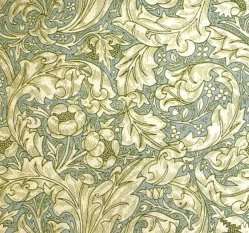16 June 2003
This Wallpaper is Killing Me
Environmentalist, on the board of chemical company, peddles poison products? A 19th century scandal unfolds in the 21st.
William Morris (1834-1896) was a poet, craftsman, designer, writer, typographer, socialist, an early environmentalist and design critic, and a founder of the Arts and Crafts movement. The movement in the UK and later in the United States aimed to raise the status of decorative arts, to celebrate craftsmanship and beauty in objects and furnishings. The movement was a response to industrialization, mass-production, and the alienation of workers from their craft and creativity. The movement campaigned for ethics and aesthetics in design, and celebrated craftsmanship, quality, and service it associated with the medieval guild system. Designers were encouraged to promote spiritual and humanist rather than commercial values, and to sell their wares to the public at a low price while fairly compensating the craftsman.
However, a paper published in the June 12, 2003 issue of the journal Nature finds that Morris used arsenic in the pigments of his wallpapers, despite widespread reports of its toxicity. The findings are a shocking contradiction to Morris’s design humanism.
From Wired News:
“William Morris is famous for creating beautiful tapestry designs, full of lush green leaves and vines, in the late 19th century.
A new study shows that Morris derived the color green from a dangerous source: arsenic. His father owned the processing plant that became the major supplier of arsenic used in green pigments in 1867. Morris made his own fortune from shares in the company, Devon Great Consols, and served on the board.
The researcher who performed the study found evidence that Morris turned a blind eye to the possible danger in which he placed his customers. Ironically, Morris was outspoken about his disgust with industry’s dehumanizing and polluting practices.
‘He was on the board of directors of an arsenic mining company,’ said Andy Meharg of the school of biological sciences at the University of Aberdeen in Great Britain whose study was published in Nature. ‘It is hard to believe that the health concerns of mining and processing of arsenic were not discussed at board meetings.’
Even in the late 1800s, the danger of arsenic exposure was well established. Workers at DGC suffered from painful skin lesions known as arsenic ‘pock,’ and many died from arsenic-related lung diseases, Meharg writes.
 Yet Morris dismissed the assertion that arsenic was poisonous in letters to Thomas Wardle, his dye manufacturer. Wardle wrote Morris telling him that one of his customers was concerned that the wallpaper he had bought from Morris was making him and his wife sick.
Yet Morris dismissed the assertion that arsenic was poisonous in letters to Thomas Wardle, his dye manufacturer. Wardle wrote Morris telling him that one of his customers was concerned that the wallpaper he had bought from Morris was making him and his wife sick.
‘As to the arsenic scare, a greater folly is hardly possible to imagine: The doctors were being bitten by witch fever,’ he wrote in a letter dated Oct. 3, 1885, according to Meharg.
The William Morris Gallery in London donated a small sample of one of Morris’ original wallpapers with the trellis design to analyze.
‘I analyzed the green pigment by energy-dispersive analysis and showed unequivocally that the coloration was caused by a copper arsenic salt,’ Meharg wrote. ‘The beauty that William Morris wallpapers brought to a room must have had a health cost, at least in damp rooms.’
In damp rooms, Mehard said, fungi living on the wallpaper paste turned the arsenic salts into highly toxic trimethylarsine. Arsenic pigments, which were also used extensively in paints and to dye clothes, paper, cardboard, food, soap, and artificial and dried flowers, were responsible for untold numbers of cases of chronic illness and many deaths.
The William Morris Society did not return phone calls requesting comment.
In addition to art and design, Morris was known for being an outspoken socialist as well as an environmentalist. He was a co-founder of the Arts and Crafts movement, and is described by art historians as someone who sought to ‘shift workers out of numbing factory jobs into uplifting crafts where a healthy mind, body and spirit could be achieved.’
So his dismissal of the misery that arsenic clearly caused workers in the factory his father owned — that gave him the means to start his firm, Morris, Marshall, Faulkner & Co. (later changed to Morris & Co) — is troubling. But Meharg tries to give Morris the benefit of the doubt.
‘In his defense, he was a product of his age, when environmentalism was in its infancy,’ he writes in the Nature paper. ‘He was actually a positive force in this movement. His political creed developed over several decades, and by the end of his life, when he was most revolutionary, his links with industry were in the past.’”
See coverage in the Independent or Nature’s own article about the paper. You can download the full text of the paper if you are a Nature subscriber or are willing to cough up $18 for the article.

